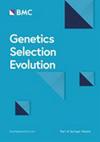插入猪基因组的线粒体来源核序列(NUMT)综合图集
IF 3.1
1区 农林科学
Q1 AGRICULTURE, DAIRY & ANIMAL SCIENCE
引用次数: 0
摘要
将核线粒体 DNA(mtDNA)整合到哺乳动物基因组中是一个持续但罕见的进化过程,这一过程会产生线粒体来源的核序列(NUMT)。在这项研究中,我们鉴定并分析了插入猪(Sus scrofa)基因组和其他几个蹄目物种基因组中的 NUMT。首先,我们构建了 NUMT 在 Sscrofa11.1 参考基因组、22 个其他已组装的 S. scrofa 基因组(来自亚洲和欧洲的猪种和种群)以及鄢陵疣猪(Sus cebifrons)和疣猪(Phacochoerus africanus)已组装基因组中的比较分布图。然后,我们分析了来自不同品种、种群或 Sus 种类的总共 485 个全基因组测序数据集,以发现多态 NUMT(在猪基因组中插入/删除)。根据不同物种基因组中是否存在同源 NUMT,并考虑到其进化差异,推断出插入年龄。此外,还根据与真实 mtDNA 序列相比的序列退化情况计算了 NUMT 的年龄。我们还通过 PCR 扩增验证了一组具有代表性的 NUMT。我们构建了一个包含 418 个 NUMT 区域的图集,其中 70 个区域不存在于任何已组装的基因组中。我们发现了古老的 NUMT 区域(早于 5,500 万年前,Mya)以及在 Suinae 进化过程中不同时间点出现的 NUMT。我们发现了非常新的多态 NUMT(S. scrofa 特有,小于 1 Mya),以及存在于不同苏氏物种中的更古老的多态 NUMT(3.5-10 Mya)。这些最新的多态 NUMT 区域在欧洲和亚洲的猪种和种群中出现分离,很可能是 Sus 属种间混杂的结果。本研究首次对苏门答腊猪基因组中的 NUMT 进行了全面分析,并将其与鲸目动物中其他物种的 NUMT 进行了比较。我们根据 NUMT 整合年龄重建的基于 NUMT 的进化窗口有助于更好地理解塑造现代猪基因组和丰富该物种遗传多样性的微进化事件。本文章由计算机程序翻译,如有差异,请以英文原文为准。
A comprehensive atlas of nuclear sequences of mitochondrial origin (NUMT) inserted into the pig genome
The integration of nuclear mitochondrial DNA (mtDNA) into the mammalian genomes is an ongoing, yet rare evolutionary process that produces nuclear sequences of mitochondrial origin (NUMT). In this study, we identified and analysed NUMT inserted into the pig (Sus scrofa) genome and in the genomes of a few other Suinae species. First, we constructed a comparative distribution map of NUMT in the Sscrofa11.1 reference genome and in 22 other assembled S. scrofa genomes (from Asian and European pig breeds and populations), as well as the assembled genomes of the Visayan warty pig (Sus cebifrons) and warthog (Phacochoerus africanus). We then analysed a total of 485 whole genome sequencing datasets, from different breeds, populations, or Sus species, to discover polymorphic NUMT (inserted/deleted in the pig genome). The insertion age was inferred based on the presence or absence of orthologous NUMT in the genomes of different species, taking into account their evolutionary divergence. Additionally, the age of the NUMT was calculated based on sequence degradation compared to the authentic mtDNA sequence. We also validated a selected set of representative NUMT via PCR amplification. We have constructed an atlas of 418 NUMT regions, 70 of which were not present in any assembled genomes. We identified ancient NUMT regions (older than 55 million years ago, Mya) and NUMT that appeared at different time points along the Suinae evolutionary lineage. We identified very recent polymorphic NUMT (private to S. scrofa, with < 1 Mya), and more ancient polymorphic NUMT (3.5–10 Mya) present in various Sus species. These latest polymorphic NUMT regions, which segregate in European and Asian pig breeds and populations, are likely the results of interspecies admixture within the Sus genus. This study provided a first comprehensive analysis of NUMT present in the Sus scrofa genome, comparing them to NUMT found in other species within the order Cetartiodactyla. The NUMT-based evolutionary window that we reconstructed from NUMT integration ages could be useful to better understand the micro-evolutionary events that shaped the modern pig genome and enriched the genetic diversity of this species.
求助全文
通过发布文献求助,成功后即可免费获取论文全文。
去求助
来源期刊

Genetics Selection Evolution
生物-奶制品与动物科学
CiteScore
6.50
自引率
9.80%
发文量
74
审稿时长
1 months
期刊介绍:
Genetics Selection Evolution invites basic, applied and methodological content that will aid the current understanding and the utilization of genetic variability in domestic animal species. Although the focus is on domestic animal species, research on other species is invited if it contributes to the understanding of the use of genetic variability in domestic animals. Genetics Selection Evolution publishes results from all levels of study, from the gene to the quantitative trait, from the individual to the population, the breed or the species. Contributions concerning both the biological approach, from molecular genetics to quantitative genetics, as well as the mathematical approach, from population genetics to statistics, are welcome. Specific areas of interest include but are not limited to: gene and QTL identification, mapping and characterization, analysis of new phenotypes, high-throughput SNP data analysis, functional genomics, cytogenetics, genetic diversity of populations and breeds, genetic evaluation, applied and experimental selection, genomic selection, selection efficiency, and statistical methodology for the genetic analysis of phenotypes with quantitative and mixed inheritance.
 求助内容:
求助内容: 应助结果提醒方式:
应助结果提醒方式:


